(CNN) -- Video propaganda showing the White House and Congress being blown up. Talk of hitting U.S. bases in the Pacific. The reunciation of a 60-year-old armistice that has kept the tenuous peace on the Korean Peninsula.
It seems barely a day passes without another North Korean threat, and coming after the December launch of a long-range rocket and a third nuclear test in February, the florid declarations from Pyongyang have gotten the attention of the United States and its allies.
More: North Korea touts its human rights credentials
So why now, and how nervous should you be? Here are five things to consider.
It's an inside game ...
Numerous analysts on both sides of the Pacific attribute the aggressive posture is part of an attempt by North Korea's young leader Kim Jong Un to consolidate his power in the reclusive communist state founded by his grandfather.
.cnnArticleGalleryNav{border:1px solid #000;cursor:pointer;float:left;height:25px;text-align:center;width:25px} .cnnArticleGalleryNavOn{background-color:#C03;border:1px solid #000;float:left;height:25px;text-align:center;width:20px} .cnnArticleGalleryNavDisabled{background-color:#222;border:1px solid #000;color:#666;float:left;height:25px;text-align:center;width:25px} .cnnArticleExpandableTarget{background-color:#000;display:none;position:absolute} .cnnArticlePhotoContainer{height:122px;width:214px} .cnnArticleBoxImage{cursor:pointer;height:122px;padding-top:0;width:214px} .cnnArticleGalleryCaptionControl{background-color:#000;color:#FFF} .cnnArticleGalleryCaptionControlText{cursor:pointer;float:right;font-size:10px;padding:3px 10px 3px 3px} .cnnArticleGalleryPhotoContainer cite{background:none repeat scroll 0 0 #000;bottom:48px;color:#FFF;height:auto;left:420px;opacity:.7;position:absolute;width:200px;padding:10px} .cnnArticleGalleryClose{background-color:#fff;display:block;text-align:right} .cnnArticleGalleryCloseButton{cursor:pointer} .cnnArticleGalleryNavPrevNext span{background-color:#444;color:#CCC;cursor:pointer;float:left;height:23px;text-align:center;width:26px;padding:4px 0 0} .cnnArticleGalleryNavPrevNextDisabled span{background-color:#444;color:#666;float:left;height:23px;text-align:center;width:25px;padding:4px 0 0} .cnnVerticalGalleryPhoto{padding-right:68px;width:270px;margin:0 auto} .cnnGalleryContainer{float:left;clear:left;margin:0 0 20px;padding:0 0 0 10px}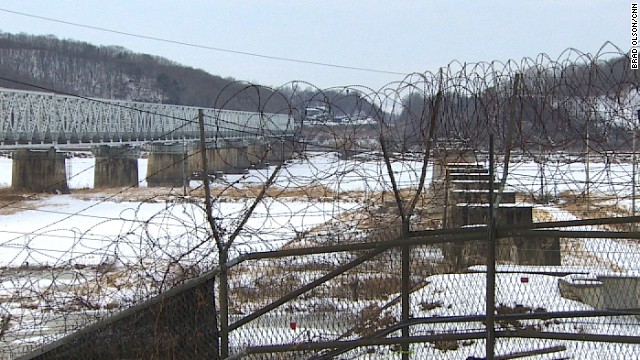 As part of the terms of the armistice that ended the Korean War in 1953, the opposing armies pulled back their frontline positions to create a 4-km-wide demilitarized zone. CNN cameraman Brad Olson shares his images of the DMZ. When the two Koreas meet for talks, they do so in the Joint Security Area (JSA) in Panmunjun, an abandoned village that straddles the DMZ. Our guide stressed to us that we were in an active war zone and should not surprise the other side with "sudden actions" such as shouting and gesturing. We were also made to stay within a very limited area. One North Korean soldier observes us closely with his binoculars through the icicles. We visited a high point overlooking Kijongdong village, which is located about 2 km away on the North Korean side within the DMZ. The village of Kijongdong is located on the North's side of the DMZ. South Korean troops refer to it as a "Propaganda Village," as they believe it is largely uninhabited and just for show. A North Korean flag flies over the village of Kijongdong. It must be one of the tallest flagpoles in the world. The Bridge of No Return is where prisoner exchanges were held at the end of the Korean War. We were warned again not to stray into restricted areas or make any sudden gestures. Pointing is considered a hostile act here. On the other side of the bridge, we spotted some North Korean soldiers looking back from behind the barbed wire, as well as a farmer herding goats in the field. Peninsula divided Neutral venue On edge On guard Inside the North Just for show Full mast Bridging the divide Just watching HIDE CAPTION << <
As part of the terms of the armistice that ended the Korean War in 1953, the opposing armies pulled back their frontline positions to create a 4-km-wide demilitarized zone. CNN cameraman Brad Olson shares his images of the DMZ. When the two Koreas meet for talks, they do so in the Joint Security Area (JSA) in Panmunjun, an abandoned village that straddles the DMZ. Our guide stressed to us that we were in an active war zone and should not surprise the other side with "sudden actions" such as shouting and gesturing. We were also made to stay within a very limited area. One North Korean soldier observes us closely with his binoculars through the icicles. We visited a high point overlooking Kijongdong village, which is located about 2 km away on the North Korean side within the DMZ. The village of Kijongdong is located on the North's side of the DMZ. South Korean troops refer to it as a "Propaganda Village," as they believe it is largely uninhabited and just for show. A North Korean flag flies over the village of Kijongdong. It must be one of the tallest flagpoles in the world. The Bridge of No Return is where prisoner exchanges were held at the end of the Korean War. We were warned again not to stray into restricted areas or make any sudden gestures. Pointing is considered a hostile act here. On the other side of the bridge, we spotted some North Korean soldiers looking back from behind the barbed wire, as well as a farmer herding goats in the field. Peninsula divided Neutral venue On edge On guard Inside the North Just for show Full mast Bridging the divide Just watching HIDE CAPTION << <  1
1  2
2  3
3  4
4  5
5  6
6  7
7  8
8  9 > >>
9 > >> 
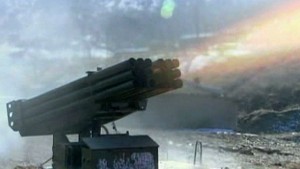 Which North Korean threats are real?
Which North Korean threats are real? 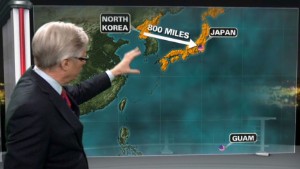 Ominous new threat from North Korea
Ominous new threat from North Korea  N. Korea threatens U.S. military bases
N. Korea threatens U.S. military bases "First and foremost, it's for his domestic audience," said Jasper Kim, founder of the Asia-Pacific Global Research Group in Seoul, South Korea. "Because without the support of the military, he won't be around for much longer. And so he has to bolster his support with the brass."
That's a tough sell for North Korea, "where age matters," he added. Kim is believed to be 29.
More: Kim Jong Un's life
Peter Hayes, director of the San Francisco-based Nautilus Institute, says there's also a debate going on inside the North Korean leadership about the country's future as a nuclear state.
One side wants "to be a nuclear-armed state that is able to behave like the recognized, legal nuclear weapons states and play their game and turn the tables on them," Hayes said.
"That is, in my view, what is going on in the test and the rocket firing," he said. "The other policy current is associated with the Ministry of Foreign Affairs and the international faction of the Korean Worker's Party, which is to negotiate our way out of this mess."
A recent statement from the foreign ministry declared that North Korea would not give up its nuclear "sacred sword" as long as the United States remains hostile -- a conditional statement that signals Pyongyang may be willing to give up the bomb under the right circumstances, Hayes said.
... But the talk is bigger this time
"They say a lot of these kind of things, so there's a tendency to treat it as the kind of stream of crazy you get from North Korea," said Jeffrey Lewis, East Asia director at the California-based James Martin Center for Nonproliferation Studies. "But this is not normal. It is more vitriolic."
A recent statement by a top North Korean general specifically talked of hitting Washington with a nuclear weapon in the event of war. "That's a pretty direct threat," Lewis said.
More: Timeline of North Korea's threats
The North Korean rhetoric ramped up after the February 12 nuclear test and the U.N. sanctions that followed. Meanwhile, Victor Cha, director of Asian Studies at Georgetown University and former director for Asian affairs at the National Security Council, told CNN's "Fareed Zakaria GPS" that North Korea has carried out some sort of military provocation within 14 weeks of every South Korean presidential inauguration since 1992. South Korean President Park Geun-hye took office on February 25, "so start the clock," he said.
"What is not normal is that the backdrop for this is about a year of very unpredictable behavior by a new leadership, and a sequence of provocations that is more concentrated over a period of time than we have seen in the last 20 years," he said. "So in that context, although to the average listener these threats may seem like it's just the North Koreans firing their mouths off again, for those of us that look at this more closely this is a little bit different -- and more concerning."
Their nukes aren't useful ... yet
Most observers say Pyongyang is still years away from having the technology to deliver a nuclear warhead on a missile. While its scientists managed to lob a small satellite into space in December, putting a working device atop a missile, launching it and hitting a target with it is vastly more complicated, Hayes said.
More: Nuclear weapons: Who has what
But Lewis, who also runs the Arms Control Wonk blog, said the North Koreans may have tried to "skip a step" with its early bomb tests and build one small enough to fit on a missile. That might explain why its first two were relatively unsuccessful.
"I think it's plausible to think that they have a warhead design in which they are confident that's under 1,000 kilograms (2,200 pounds) -- still not as small as you need to put on a missile and launch it to the U.S., but closer than they were a couple of years ago," he said.
And while Washington hasn't come out and said it, Lewis said the March 15 announcement that the Pentagon will deploy additional ground-based missile interceptors on the West Coast may signal that the North Koreans have deployed a long-range missile they put on display at a parade in 2012. Lewis said the announcement was "mostly for show," but could reflect real U.S. concerns about those missiles.
"If you're going to spend $1 billion to deploy interceptors, they ought to come right out and say it," he said.
But nukes aren't everything
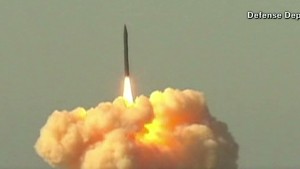 U.S. to boost missile defense
U.S. to boost missile defense  Kim Jong Un: Break enemies' waists
Kim Jong Un: Break enemies' waists  Rodman: Kim Jong Un's 'my friend'
Rodman: Kim Jong Un's 'my friend' 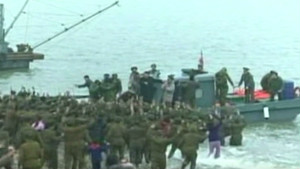 They raced into sea for Kim Jong Un
They raced into sea for Kim Jong Un North Korea also has plenty of conventional military firepower, including medium-range ballistic missiles that can carry high explosives for hundreds of miles, as well as thousands of cannons, rocket launchers and tanks massed across the Demilitarized Zone that separates North and South. Seoul is within range of many of those weapons, and the North has threatened before to turn the southern capital into a "sea of fire."
A North Korean bombardment could kill tens of thousands of people in Seoul before South Korean and U.S. retaliation could smash those guns, Hayes said. But that would essentially launch a new Korean War -- one he said would end badly for the long-impoverished North.
"They have less than 30 days of fuel and no ability to refuel," he said. "They've got to fight a very short war before they're just walking to where they're going to fight."
Pyongyang keeps its forces massed on the DMZ "precisely because they're weak," he said.
There are other avenues. When computers at South Korean banks and broadcasters began to crash on Wednesday, suspicion initially fell on the North. South Korea has accused the North of similar hacking attacks before, including incidents in 2010 and 2012 that also targeted banks and media organizations. Adam Segal, a cybersecurity expert with the Council on Foreign Relations, said the hacking is consistent with previous North Korean actions.
So now what?
For years, Pyongyang has made deals to curtail its nuclear and missile work in exchange for economic aid. Those deals have fallen apart when the North went on to conduct other tests. The six-party talks among the North, its Asian neighbors and the United States fizzled in 2007, and the North's first attempt at a satellite launch scotched a previous U.S. plan to trade hundreds of thousands of tons of food for a halt to weapons work.
"I think the problem right now is that you cannot engage them directly after they have done a series of ballistic missile and nuclear tests, and we are going into a period of sanctions now through the U.N. Security Council resolution," Cha said.
"They don't want to give up their nuclear weapons. They want to be able to have their cake and eat it, too. And U.S. policy for the past quarter-century has been these things are all on the table if you are willing to give up your nuclear weapons," he said. "And so this is the problem. This is the dilemma right now."
Meanwhile, the United States is going ahead with joint U.S.-South Korean military exercises amid the North Korean threats, adding a special little twist -- overflights by massive B-52 bombers. It's a move reminiscent of the worst days of the Cold War, and one Hayes called "tactically smart but strategically stupid."
"The North Koreans will have noted it for what it is -- an affirmation of the fact that we're playing the nuclear game with North Korea, and that's the last thing we want to do," he said. "I think our posture is either to persuade ourselves that we're hanging tough, which is a domestic game in Washington, or to reassure our allies and dissuade South Korea from going it alone with nuclear weapons."
But both Hayes and Lewis said there's little to lose by continuing to engage the North.
"We do what we can on defense, and if the North Koreans want to bargain or haggle, I'm prepared to do that," Lewis said.
READ MORE: 5 ways North Korea is getting stranger
READ MORE: Angry over U.N. inquiry, North Korea touts its human rights credentials
READ MORE: North Korea warns that U.S. bases in Guam, Japan are within range
READ MORE: North Korea declares 1953 armistice invalid
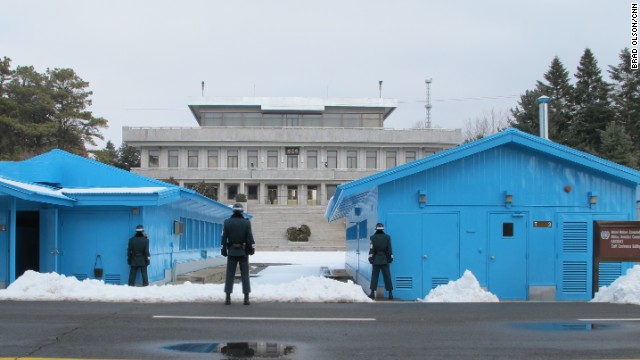 When the two Koreas meet for talks, they do so in the Joint Security Area (JSA) in Panmunjun, an abandoned village that straddles the DMZ.
When the two Koreas meet for talks, they do so in the Joint Security Area (JSA) in Panmunjun, an abandoned village that straddles the DMZ.  Our guide stressed to us that we were in an active war zone and should not surprise the other side with "sudden actions" such as shouting and gesturing. We were also made to stay within a very limited area.
Our guide stressed to us that we were in an active war zone and should not surprise the other side with "sudden actions" such as shouting and gesturing. We were also made to stay within a very limited area. 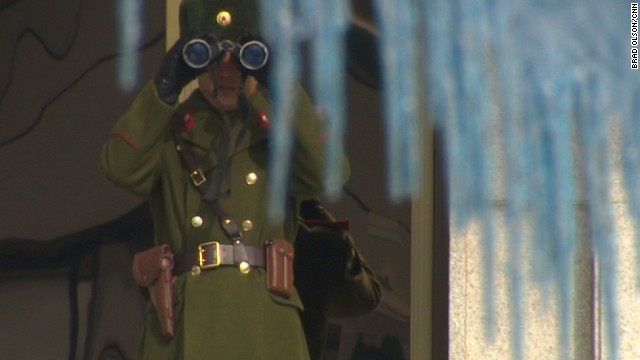 One North Korean soldier observes us closely with his binoculars through the icicles.
One North Korean soldier observes us closely with his binoculars through the icicles. 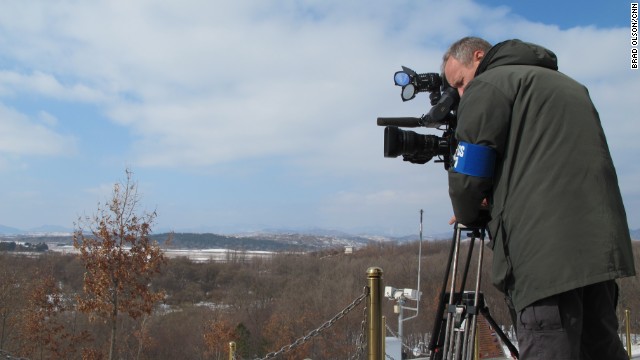 We visited a high point overlooking Kijongdong village, which is located about 2 km away on the North Korean side within the DMZ.
We visited a high point overlooking Kijongdong village, which is located about 2 km away on the North Korean side within the DMZ. 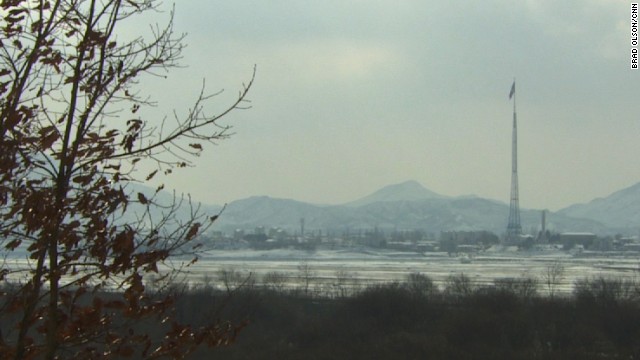 The village of Kijongdong is located on the North's side of the DMZ. South Korean troops refer to it as a "Propaganda Village," as they believe it is largely uninhabited and just for show.
The village of Kijongdong is located on the North's side of the DMZ. South Korean troops refer to it as a "Propaganda Village," as they believe it is largely uninhabited and just for show. 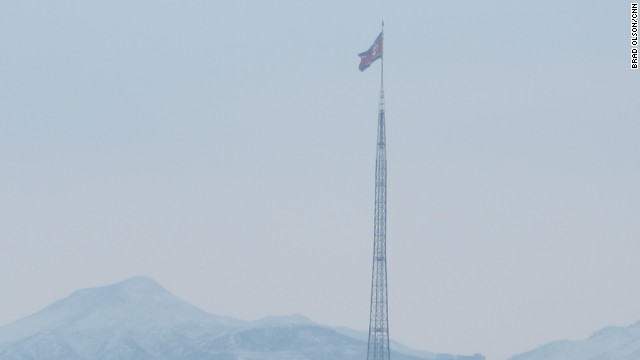 A North Korean flag flies over the village of Kijongdong. It must be one of the tallest flagpoles in the world.
A North Korean flag flies over the village of Kijongdong. It must be one of the tallest flagpoles in the world. 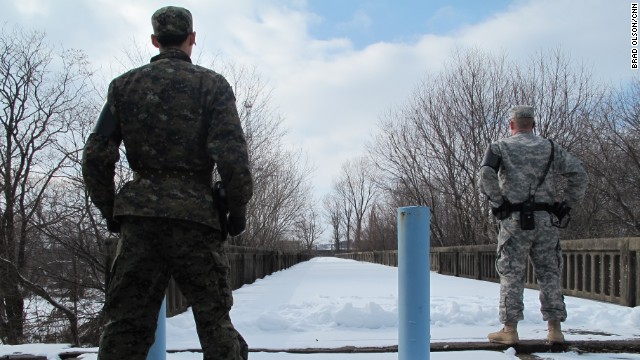 The Bridge of No Return is where prisoner exchanges were held at the end of the Korean War. We were warned again not to stray into restricted areas or make any sudden gestures. Pointing is considered a hostile act here.
The Bridge of No Return is where prisoner exchanges were held at the end of the Korean War. We were warned again not to stray into restricted areas or make any sudden gestures. Pointing is considered a hostile act here. 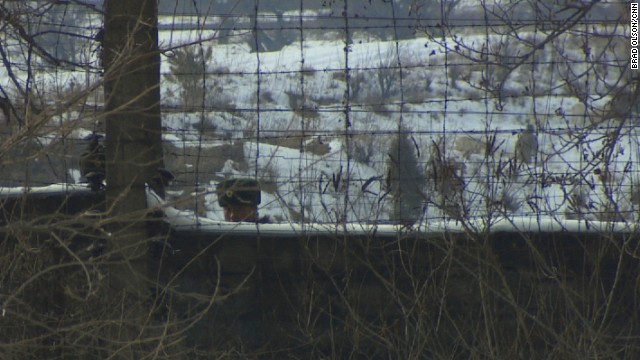 On the other side of the bridge, we spotted some North Korean soldiers looking back from behind the barbed wire, as well as a farmer herding goats in the field. Peninsula divided Neutral venue On edge On guard Inside the North Just for show Full mast Bridging the divide Just watching HIDE CAPTION << <
On the other side of the bridge, we spotted some North Korean soldiers looking back from behind the barbed wire, as well as a farmer herding goats in the field. Peninsula divided Neutral venue On edge On guard Inside the North Just for show Full mast Bridging the divide Just watching HIDE CAPTION << <
{ 0 comments... read them below or add one }
Post a Comment